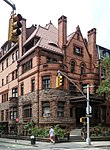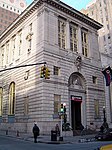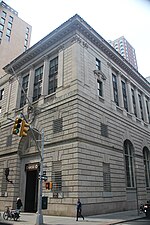Brooklyn Arts Gallery
The Brooklyn Arts Gallery was Brooklyn's first art gallery. Located in the borough's Brooklyn Heights neighborhood in New York City, the gallery first opened on January 22, 1958, with the purpose being to "provide facilities where artists may display their work to the public at a minimum cost and without red tape." Open to the public and free of charge to both patrons and artists, the gallery was privately established for the benefit of lesser-known artists in Brooklyn by its founder and director, Sylvia Dwyer. The Gallery's exhibits of paintings, drawings, prints, sculptures, and ceramics reflected many artistic movements of that era, including expressionism, realism, modern, non-objective, and abstraction. Throughout the 1960s, the gallery remained a center for artists and was heralded for its cultural influence on the neighborhood.
Excerpt from the Wikipedia article Brooklyn Arts Gallery (License: CC BY-SA 3.0, Authors).Brooklyn Arts Gallery
Remsen Street, New York Brooklyn
Geographical coordinates (GPS) Address Nearby Places Show on map
Geographical coordinates (GPS)
| Latitude | Longitude |
|---|---|
| N 40.6943 ° | E -73.9941 ° |
Address
Our Lady of Lebanon Roman Catholic Church
Remsen Street 109
11201 New York, Brooklyn
New York, United States
Open on Google Maps








